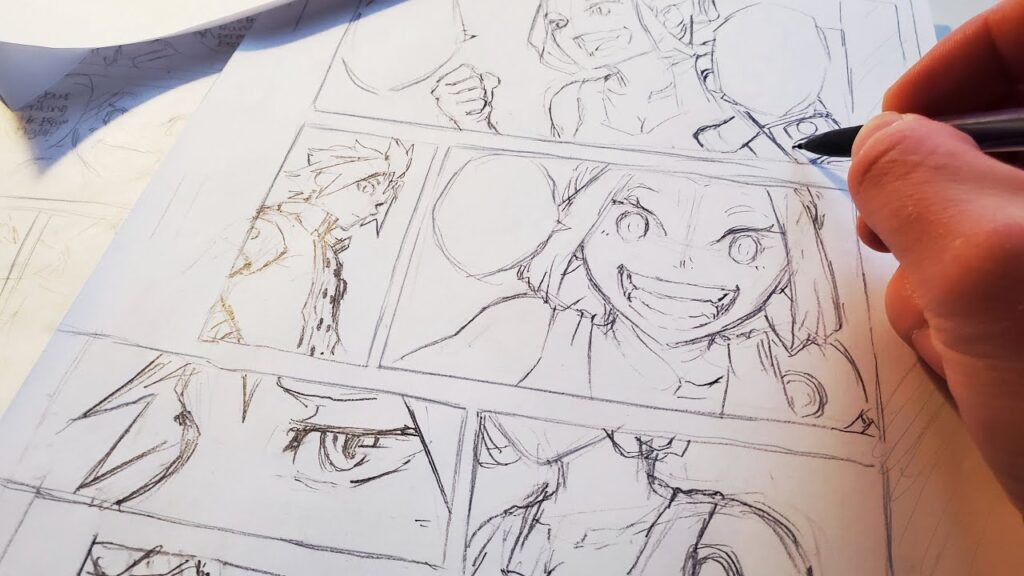Introduction: The Brutal Reality of Making Manga
Ever wondered how One Piece gets made every week? Or why Berserk went on hiatus so often? The manga industry runs on a grueling production cycle that pushes creators to their limits. This insider’s guide reveals:
✅ The 6-step manga creation process (most fans only see the final product)
✅ Why even legends like Togashi (Hunter x Hunter) struggle with deadlines
✅ How editors influence iconic series (for better or worse)
✅ The dark side of the industry (overwork, health crises, and censorship battles)
1. The Manga Creation Assembly Line: How a Chapter Gets Made
Step 1: Storyboarding (Name)
- The mangaka sketches a rough draft with stick figures and scribbled dialogue
- Example: Eiichiro Oda draws 3-4 versions of One Piece chapters before finalizing
Step 2: Penciling (Genga)
- Clean line art is drawn over the storyboard
- Time crunch: Most artists only get 1-2 days per chapter for this
Step 3: Inking (Penki)
- Assistants trace pencil lines with ink (this is why some manga have “same-face syndrome”)
- Fun fact: Gege Akutami (Jujutsu Kaisen) does all inking himself for consistency
Step 4: Screen Tones & Effects
- Shadows/textures are added via digital tools or traditional glue-on sheets
- Old-school method: Kentaro Miura hand-cut every tone in Berserk (took weeks per page)
Step 5: Editing & Revisions
- Editors demand changes (e.g., Naruto’s ending was rewritten 3 times)
- Famous clash: Tite Kubo fought Shueisha to keep Bleach’s darker tone
Step 6: Printing & Distribution
- Chapters are sent to magazines (Weekly Shonen Jump prints **2.5 million copies weekly*)
Shocking Fact: A single chapter can take 80-100 hours to complete.
2. The Human Cost: Why So Many Mangaka Collapse
The Weekly Shonen Jump Grind
- Schedule: 18-hour days, 3 hours of sleep (confirmed by Black Clover’s Yuki Tabata)
- Health toll: Hiromu Arakawa (Fullmetal Alchemist) developed carpal tunnel syndrome
Hiatus Hell
| Mangaka | Series | Hiatus Reason |
| Togashi | Hunter x Hunter | Chronic back pain (can’t sit to draw) |
| Miura | Berserk | Passed away from aortic dissection (overwork contributed) |
| Ishida Sui | Tokyo Ghoul | Severe depression |
Fan Paradox: Readers demand faster releases but don’t want another Miura tragedy.
3. Editor Influence: The Hidden Architects of Manga Creation
When Editors Save a Series
- One Piece: Editor convinced Oda to keep Luffy’s straw hat (was almost cut)
- Dragon Ball: Told Toriyama to add power levels (created the Saiyan Saga)
When Editors Ruin a Series
- Bleach: Forced Kubo to introduce fullbringers (ratings plummeted)
- The Promised Neverland: Pushed Kaiu Shirai to rush the ending
Power Dynamic: Most rookie mangaka can’t refuse editor demands.
4. Digital vs. Traditional: The Changing Industry
Old School (Pre-2010s)
- Hand-drawn on B4 paper with G-pen nibs
- Takehiko Inoue (Vagabond) used calligraphy brushes for ink washes
New School (Digital Dominance)
- Clip Studio Paint is now industry standard
- Pros: Faster editing, no scanning
- Cons: “Soulless” uniformity (fans complain about generic digital sheen)
Hybrid Heroes: Junji Ito still draws analog first, then scans for tones.
FAQ: The Truth About Manga Production
Q: Why don’t mangaka hire more assistants?
A: Money. A top artist (like Oda) gets $500k/year—but assistants make $15k.
Q: How much does a mangaka earn per volume?
A: $0.50-$2.00 per copy (so One Piece Vol. 107 = ~$2 million for Oda).
Q: Do editors really reject famous series?
A: Yes. Attack on Titan was rejected 12 times before Kodansha picked it up.
Conclusion: Can the Industry Change?
With digital platforms (Webtoon, Shonen Jump+) and unionization efforts, younger artists are fighting for better conditions. But the “work till you drop” culture persists.
What’s the solution? Supporting smaller publishers (like Denpa) that prioritize creator health.
Final Thought: Next time you read Jujutsu Kaisen, remember—Akutami is probably sleep-deprived while making it.



